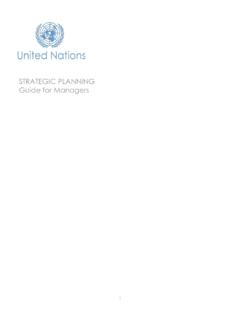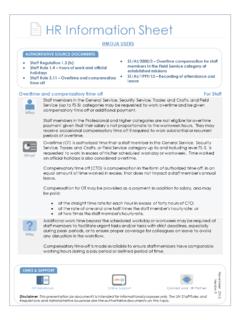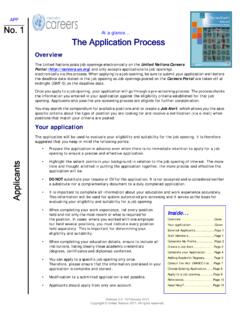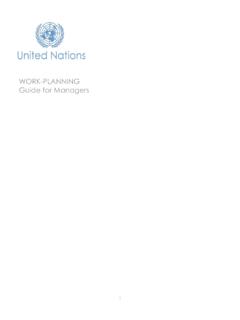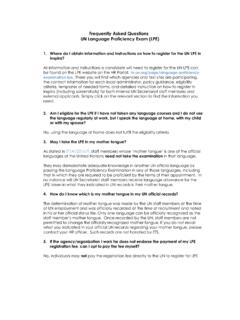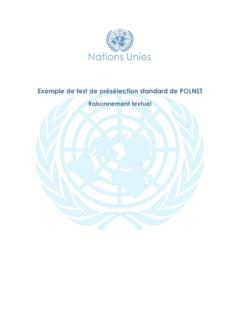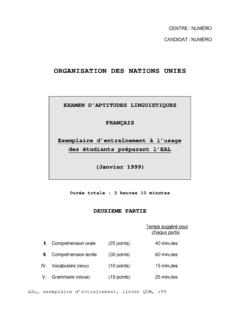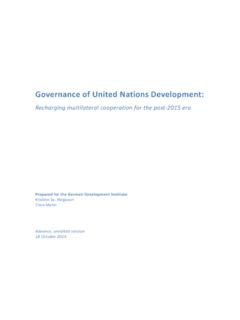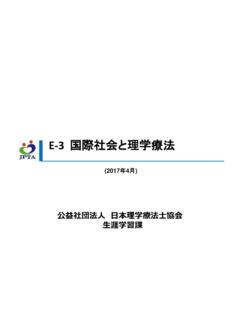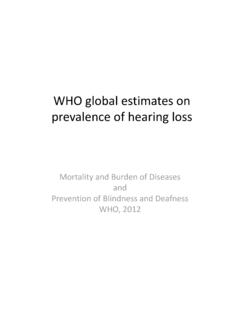Transcription of Office of Human Resources Department of Management ...
1 Office of Human Resources Department of Management Strategy, Policy and Compliance United Nations New York, January 2020 Table of Contents INTRODUCTION ..5 EQUITABLE GEOGRAPHICAL DISTRIBUTION & GREATER REGIONAL GROUP DIVERSITY ..6 Equitable Geographical Distribution ..6 Greater Regional Group Diversity ..7 Geographical Representation & Regional Group Diversity ..9 THE GEOGRAPHICAL DIVERSITY STRATEGY .. 11 The First Stream: Internal Direction, Awareness and Knowledge .. 12 The Second Stream: Attracting New Talent with Renewed Focus .. 17 The Third Stream: Leveraging on Partnerships and Networks.
2 19 5 Introduction While securing the highest standards of efficiency, competence and integrity due regard should be paid to recruiting staff on as wide a geographical basis as possible - Article 101 of the United Nations (UN) Charter. The diversity and complexity of the global UN presence and mandates must be matched by a diverse, geographically balanced, gender-balanced, international and multitalented workforce that visibly demonstrates its core values, has a modelling impact on the communities it serves, and reaps the gains in efficiency, productivity and innovation from the diverse peoples of the world.
3 Realizing such a workforce enhances the Organization s ability to reflect diverse viewpoints in implementing and meeting its mandates that touch upon the lives of people worldwide and to gear up to a decade of action and delivery for sustainable development by 2030. With the aims of realizing such a workforce at the UN Secretariat, the Organization embraces multiple goals reflecting diversity and inclusion, both in the composition of its staff and in the organizational culture as embodied in the UN. In so doing, the current strategy aims to address the element of greater geographical diversity , one of the cornerstones of the diverse workforce envisaged by the Secretary-General.
4 The strategy focuses on two principal areas under the overarching concept of greater geographical diversity: (1) equitable geographical representation; and (2) greater regional group diversity. In making progress towards achieving equitable geographical representation, the goal is to have every unrepresented Member State be represented in the Organization and to bring as many underrepresented Member States to be within range in the system of desirable ranges. For greater regional group diversity, the goal is to reduce the proportion of the most highly represented regional group and to increase the proportion of less represented regional groups, thereby reducing the overall imbalance of the regional group diversity composition of staff at the UN.
5 Despite efforts at attaining equitable geographical distribution and greater regional group diversity in the UN Secretariat, the Organization has been met with challenges that have hindered its progress over the years with an absence of equitable representation of all of its Member States and with an imbalance of the regional groups in the composition of its workforce. This is due primarily to challenges in supply of appli-cants from un- and underrepresented Member States, particularly from certain Arabic, pacific Island, and African Member States; a diminishing workforce due to downsizing and challenges in workforce planning and outreach by entities.
6 Also, experience suggests that visible progress requires sustained and deliberate effort during a long-term horizon. However, notwithstanding the challenges to achieving greater geographical diversity, the Secretary-General strongly believes that the diversity of the 193 Member States and peoples of the world must be celebrated and manifested in the staff of the UN, and that achieving this goal will ultimately contribute to a more diverse and inclusive workforce which exhibits the core values that the Organization upholds. Moreover, the Organization relies on respecting and learning from each other s differences to identify and cultivate innovative solutions in addressing its everyday challenges.
7 To achieve this goal of increasing the representation of unrepresented and underrepresented Member States and less represented regional groups, three streams have been established: 6 1) internal direction, messaging, guidance and monitoring and awareness campaigns targeting both the top Management and operations, and strengthened accountability mechanism; 2) outreach activities both offline and online through existing and new tools and platforms to promote jobs and improve employer brand; and 3) leveraging on the knowledge, experience and Resources of Member States, other UN organizations and international organization networks.
8 The details of this multifaceted strategy are explained in the subsequent headings, preceded by an overview of the equitable geographical distribution and regional group diversity goals. Equitable Geographical Distribution & Greater Regional Group Diversity Upon taking the oath of Office , the Secretary-General made a pledge to increase geographical diversity as one of his reform priorities. The term geographical diversity encompasses both goals of (1) equitable geographical distribution; and (2) greater regional group diversity. Equitable Geographical Distribution The General Assembly has established the system of desirable ranges as the measure for assessing the appropriate representation level of each Member State in the staff of the UN.
9 This system takes into account a subset of the international staff popula-tion, namely those who hold a permanent, continu-ing or fixed-term appointment, and encumber geo-graphical posts or have been recruited through the Young Professionals Programme. To improve geographical balance, the Secretary-General included a target for geographical appoint-ments in the Senior Manager s Compact, the UN s accountability framework. Under this target, all sen-ior managers are required to make 50% of appoint-ments to geographical posts from unrepresented and underrepresented Member States under the Compact.
10 The report of the Secretary-General 74/82 titled the Composition of the Secretariat: staff demographics summarizes the status of staff subject to the system of desirable ranges as of 31 December 2018 from page 43. While there has been a small increase in representation along with improvements in the number of Member States within range from 102 (53%) in 2016 to 108 (56%) in 2019, the number of unrepresented countries increased from 18 to 23 (see Table 1). What are geographical posts ? These are positions in the Professional and higher categories financed from the programme budget, excluding positions that are language, mission, jointly financed activities, general temporary assistance, temporary assistance for meetings.
